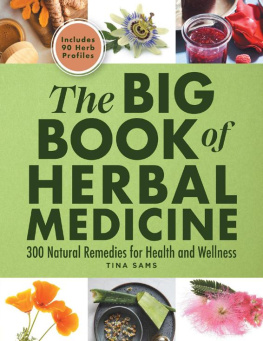Healing Herbs
A BEGINNERS GUIDE TO IDENTIFYING,
FORAGING, AND USING MEDICINAL PLANTS

Tina Sams ,
editor of The Essential Herbal

For Molly and Maryanne, my fellow woods walkers, and to all the weed workers out there who have so graciously shown me the way.
2015 Fair Winds Press
First published in the USA in 2015 by Fair Winds Press, a member of
Quarto Publishing Group USA Inc.
100 Cummings Center, Suite 406-L
Beverly, MA 01915-6101
www.fairwindspress.com
Visit www.bodymindbeautyhealth.com.
Its your personal guide to a happy, healthy, and extraordinary life!
All rights reserved. No part of this book may be reproduced or utilized, in any form or by any means, electronic or mechanical, without prior permission in writing from the publisher.
18 17 16 15 14 1 2 3 4 5
Digital edition published in 2015
Digital edition: 978-1-62788-194-4
Softcover edition: 978-1-59233-650-0
Library of Congress Cataloging-in-Publication Data
Sams, Tina.
Healing herbs : a beginners guide to identifying, foraging, and using medicinal plants / Tina Sams.
pages cm
Includes index.
ISBN 978-1-59233-650-0 -- ISBN 978-1-62788-251-4 (eISBN)
1. Herbs--Therapeutic use. 2. Herbs--Identification. I. Title.
RM666.H33S256 2015
615.321--dc23
2014025085
Photography by Shutterstock and iStock with the exception of
The information in this book is for educational purposes only. It is not intended to replace the advice of a physician or medical practitioner. Please see your health care provider before beginning any new health program.
Contents

YARROW
(Achillea millefolium)
GARLIC
(Allium sativum)
CALENDULA
(Calendula officinalis)
LAVENDER
(Lavandula spp.)
CHAMOMILE
(Matricaria recutita)
MINT
(Mentha spp.)
BASIL
(Ocimum spp.)
PASSIONFLOWER
(Passiflora spp.)
PLANTAIN
(Plantago major and Plantago lanceolata)
ROSE
(Rosa spp.)
RASPBERRY/BLACKBERRY
(Rubus spp.)
SAGE
(Salvia spp.)
ELDER
(Sambucus spp.)
CHICKWEED
(Stellaria media)
COMFREY
(Symphytum officinale)
DANDELION
(Taraxacum officinale)
THYME
(Thymus vulgaris)
STINGING NETTLE
(Urtica dioica)
SWEET VIOLET
(Viola odorata)
GINGER
(Zingiber officinale)
Introduction

T HE ROOTS OF HERBALISM extend deeper than the history of humankind. Everything that we know today follows the threads from the very beginning, woven together into a tapestry of knowledge that we tend to take for granted. Yet it is natural to seek out plants for medicine, as animals do. From the family dog eating grass for a sour stomach to chimps choosing medicinal plants for specific purposes (pain, parasites, etc.), there is a good deal of evidence that animals and humans alike turn to plants for healing. We hold innate knowledge that is often forgotten and ignored.
With the modernization of medicine, village herbalists were shunned. As an example, herbal healers in my own Pennsylvania-German region followed what is locally known as Pow-wow, or more properly, Braucherei. It is a combination of Native American healing, old German medicine, and prayer that many of the old-timers around here remember as a life-saving medicinal method, when conventional medicine failed. In the 1950s it was driven underground, as were most regional healing traditions around the world, as conventional medicine was embraced. Only in the last decade have individuals begun to work on preserving and protecting these traditions. Although some herbal healing modalities in countries such as India and China have flourished, even there the rural herbalists are currently working with people who are documenting their work and the herbs they use. In the Amazonian rainforests, researchers are racing to learn from the village herbalists before time runs out. This work is being carried out around the world as our elders pass on and we realize how very soon it can be lost forever or lost to deforestation.
As a child, I spent every possible moment outside. The plants were our toys, our companions, and our building materials. We knew what we could eat, what was poisonous, and what would cause our skin to blister. Despite the distractions of television, the Internet, and other technology, it gives me hope to see young parents encouraging their children to appreciate and enjoy the natural world. More and more parents are teaching children to find wild foods to nibble, plants to soothe a sting, and how a soft bed of pine needles on the forest floor can be the perfect place to while away an afternoon, watching the birds and the clouds.
Herbal traditions have been passed down through generations as parents and grandparents teach it to their children. That is how it has been sustained. Currently, there are many learning opportunities available without the barriers of space and time, thanks to herbalists using the Internet as a teaching tool. There is no substitute for hands-on work with the plants, however.
I started out with a good background from growing up in an agrarian region with an unquenchable desire to learn what herbs could do. My sister and I would each read a different book on herbs, switch and read the other, and then spend a week or two discussing them. I spent winters pouring over piles of field guides until the information was memorized and the pictures were as familiar as those of friends and relatives. Next came years of working with the various kinds of preparations that are made with herbsteas, tinctures, salves, soaps, and all kinds of infusions using different menstruums (solvents). Rounding up guinea pigs was not always so easy, but gradually getting to witness the miraculous healing properties of the herbs and the things I made with them gave me more and more confidence to continue learning and using them. It wasnt long before people would come looking to me for a salve or a syrup.
After opening an herb shop with my sister in the early 1990s, the education began in earnest, as we were immersed in herbs all day, every day, and found ourselves surrounded by other herbalists with new ideas and inspirations. Herbal education is ongoing. You can never know everything, but knowing five or ten herbs well is enough to make a difference, and will set you on the endless quest to know more.














